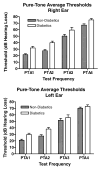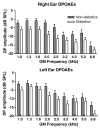Characterization of hearing loss in aged type II diabetics
- PMID: 16309862
- PMCID: PMC2745069
- DOI: 10.1016/j.heares.2005.09.002
Characterization of hearing loss in aged type II diabetics
Abstract
Presbycusis - age-related hearing loss - is the number one communicative disorder and a significant chronic medical condition of the aged. Little is known about how type II diabetes, another prevalent age-related medical condition, and presbycusis interact. The present investigation aimed to comprehensively characterize the nature of hearing impairment in aged type II diabetics. Hearing tests measuring both peripheral (cochlea) and central (brainstem and cortex) auditory processing were utilized. The majority of differences between the hearing abilities of the aged diabetics and their age-matched controls were found in measures of inner ear function. For example, large differences were found in pure-tone audiograms, wideband noise and speech reception thresholds, and otoacoustic emissions. The greatest deficits tended to be at low frequencies. In addition, there was a strong tendency for diabetes to affect the right ear more than the left. One possible interpretation is that as one develops presbycusis, the right ear advantage is lost, and this decline is accelerated by diabetes. In contrast, auditory processing tests that measure both peripheral and central processing showed fewer declines between the elderly diabetics and the control group. Consequences of elevated blood sugar levels as possible underlying physiological mechanisms for the hearing loss are discussed.
Figures








References
-
- Antcliff RJ, Marshall J. The pathogenesis of edema in diabetic maculopathy. Sem Ophthalmol. 1999;14:223–232. - PubMed
-
- Bjorbaek C, Vik TA, Echwald SM, Yang PY, Vestergaard H, Wang JP, Webb GC, Richmond K, Hansen T, Erikson RL, et al. Cloning of human insulin stimulated protein kinase (ISPK-1) gene and analysis of coding regions and mRNA levels of the ISPK-1 and protein phospahte-1 genes in muscle from NIDDM patients. Diabetes. 1995;44:90–97. - PubMed
-
- Boue-Grabot E, Archambault V, Seguela P. A protein kinase C site highly conserved in P2X subunits controls the desensitization kinetics of P2XX(2) ATO-gated channels. J Biol Chem. 2000;275:10190–10195. - PubMed
-
- Boyd-White J, Williams JC., Jr Effects of cross-linking on matrix permeability: a model for AGE-modified basement membranes. Diabetes. 1996;45:348. - PubMed
Publication types
MeSH terms
Substances
Grants and funding
LinkOut - more resources
Full Text Sources
Other Literature Sources
Medical

